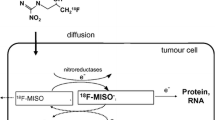Abstract
Purpose
It can be challenging to differentiate pseudoprogression from progression. We assessed the ability of dynamic contrast enhanced T1 MRI (DCE-MRI) perfusion to identify pseudoprogression in melanoma brain metastases.
Methods
Patients with melanoma brain metastases who underwent immunotherapy and DCE-MRI were identified. Enhancing lesions ≥ 5mm in diameter on DCE-MRI and that were new or increased in size between a week from beginning the treatment, and a month after completing the treatment were included in the analysis. The 90th percentiles of rVp and rKtrans and the presence or absence of hemorrhage were recorded. Histopathology served as the reference standard for pseudoprogression. If not available, pseudoprogression was defined as neurological and radiographic stability or improvement without any new treatment for ≥ 2 months.
Results
Forty-four patients were identified; 64% received ipilimumab monotherapy for a median duration of 9 weeks (range, 1–138). Sixty-four lesions in 44 patients were included in the study. Of these, nine lesions in eight patients were determined to be pseudoprogression and seven lesions were previously irradiated. Forty-four progression lesions and eight pseudoprogression lesions were hemorrhagic. Median lesion volume for pseudoprogression and progression were not significantly different, at 2.3 cm3 and 3.2 cm3, respectively (p = 0.82). The rVp90 was smaller in pseudoprogression versus progression, at 2.2 and 5.3, respectively (p = 0.02), and remained significant after false discovery rate adjustment (p = 0.04).
Conclusions
Pseudoprogression exhibited significantly lower rVp90 on DCE-MRI compared with progression. This knowledge can be useful for managing growing lesions in patients with melanoma brain metastases who are receiving immunotherapy.



Similar content being viewed by others
References
Gupta G, Robertson AG, MacKie RM (1997) Cerebral metastases of cutaneous melanoma. Br J Cancer 76(2):256–259
Bafaloukos D, Gogas H (2004) The treatment of brain metastases in melanoma patients. Cancer Treat Rev 30(6):515–520
Chiou VL, Burotto M (2015) Pseudoprogression and immune-related response in solid tumors. J Clin Oncol 33(31):3541–3543
Wolchok JD, Hoos A, O'Day S et al (2009) Guidelines for the evaluation of immune therapy activity in solid tumors: immune-related response criteria. Clin Cancer Res 15(23):7412–7420
Lin NU, Lee EQ, Aoyama H et al (2015) Response assessment criteria for brain metastases: proposal from the RANO group. Lancet Oncol 16(6):e270–278
Eisenhauer EA, Therasse P, Bogaerts J, et al. New response evaluation criteria in solid tumours: revised RECIST guideline (version 1.1). Eur J Cancer 2009;45(2):228–247.
Di Giacomo AM, Danielli R, Guidoboni M et al (2009) Therapeutic efficacy of ipilimumab, an anti-CTLA-4 monoclonal antibody, in patients with metastatic melanoma unresponsive to prior systemic treatments: clinical and immunological evidence from three patient cases. Cancer Immunol Immunother 58(8):1297–1306
Prager AJ, Martinez N, Beal K, Omuro A, Zhang Z, Young RJ (2015) Diffusion and perfusion MRI to differentiate treatment-related changes including pseudoprogression from recurrent tumors in high-grade gliomas with histopathologic evidence. AJNR Am J Neuroradiol 36(5):877–885
Young RJ, Gupta A, Shah AD et al (2013) MRI perfusion in determining pseudoprogression in patients with glioblastoma. Clin Imaging 37(1):41–49
Patel P, Baradaran H, Delgado D et al (2017) MR perfusion-weighted imaging in the evaluation of high-grade gliomas after treatment: a systematic review and meta-analysis. Neuro-oncology 19(1):118–127
Wang S, Martinez-Lage M, Sakai Y et al (2016) Differentiating tumor progression from pseudoprogression in patients with glioblastomas using diffusion tensor imaging and dynamic susceptibility contrast MRI. AJNR Am J Neuroradiol 37(1):28–36
Thomas AA, Arevalo-Perez J, Kaley T et al (2015) Dynamic contrast enhanced T1 MRI perfusion differentiates pseudoprogression from recurrent glioblastoma. J Neurooncol 125(1):183–190
Brandes AA, Franceschi E, Tosoni A et al (2008) MGMT promoter methylation status can predict the incidence and outcome of pseudoprogression after concomitant radiochemotherapy in newly diagnosed glioblastoma patients. J Clin Oncol 26(13):2192–2197
Jung SC, Yeom JA, Kim JH et al (2014) Glioma: application of histogram analysis of pharmacokinetic parameters from T1-weighted dynamic contrast-enhanced MR imaging to tumor grading. AJNR Am J Neuroradiol 35(6):1103–1110
Tofts PS, Brix G, Buckley DL et al (1999) Estimating kinetic parameters from dynamic contrast-enhanced T(1)-weighted MRI of a diffusable tracer: standardized quantities and symbols. J Magn Reson imaging 10(3):223–232
Arevalo-Perez J, Thomas AA (2015) T1-Weighted dynamic contrast-enhanced MRI as a noninvasive biomarker of epidermal growth factor receptor vIII status. AJNR Am J Neuroradiol 36(12):2256–2261
Colaco RJ, Martin P, Kluger HM, Yu JB, Chiang VL (2016) Does immunotherapy increase the rate of radiation necrosis after radiosurgical treatment of brain metastases? J Neurosurg 125(1):17–23
Okada H, Weller M, Huang R et al (2015) Immunotherapy response assessment in neuro-oncology: a report of the RANO working group. Lancet Oncol 16(15):e534–542
Pruitt AA (2015) Medical management of patients with brain tumors. Continuum (Minneap Minn). 2015;21(2 Neuro-oncology):314–331.
Funding
Research reported in this publication was partially supported by the National Cancer Institute of the National Institutes of Health under Award Number R25CA020449 and Core Grant P30 CA008748. The content is solely the responsibility of the authors and does not represent the official views of the National Institutes of Health.
Author information
Authors and Affiliations
Corresponding author
Ethics declarations
Conflict of interest
Alexander N Shoushtari is on the advisory board for Bristol-Myers Squibb, Immunocore, Castle Bioscences, and has institutional research support from Bristol-Myers Squibb, Immunocore, AstraZeneca, and Xcovery. Robert J Young consults for Agios, Puma, NordicNeuroLab, Icon, and has a grant funding from Agios. All other authors have no conflict of interests related to this study.
Additional information
Publisher's Note
Springer Nature remains neutral with regard to jurisdictional claims in published maps and institutional affiliations.
Yoshie Umemura and Diane Wang are co-first authors.
Rights and permissions
About this article
Cite this article
Umemura, Y., Wang, D., Peck, K.K. et al. DCE-MRI perfusion predicts pseudoprogression in metastatic melanoma treated with immunotherapy. J Neurooncol 146, 339–346 (2020). https://doi.org/10.1007/s11060-019-03379-6
Received:
Accepted:
Published:
Issue Date:
DOI: https://doi.org/10.1007/s11060-019-03379-6




